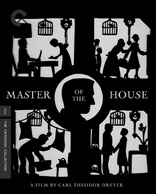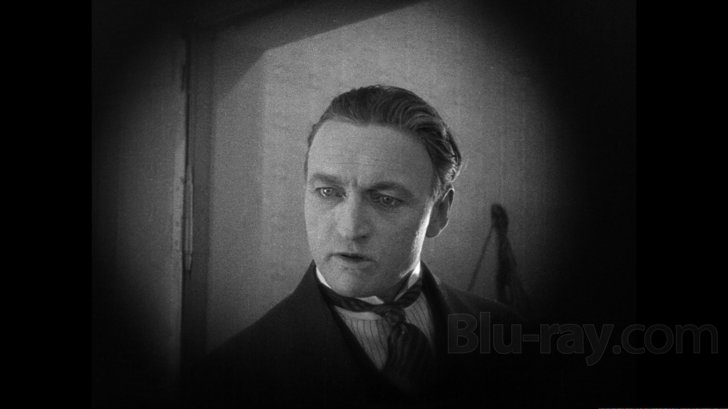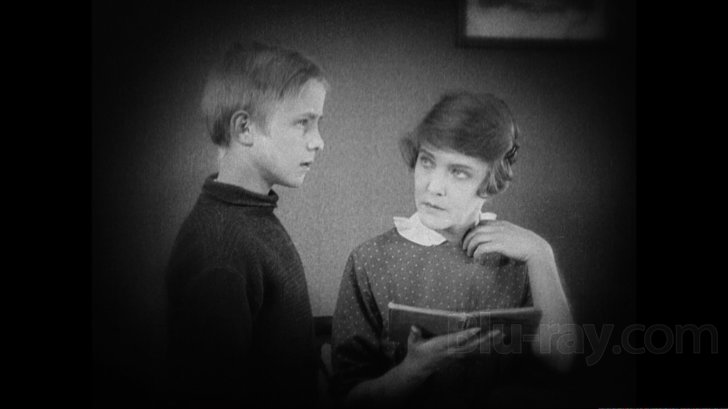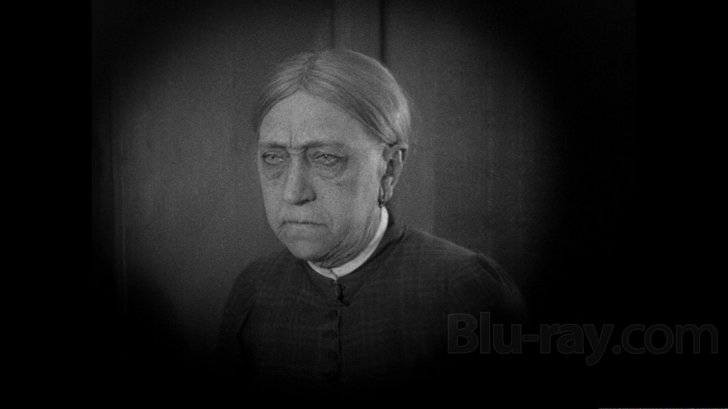Master of the House Blu-ray Movie
HomeMaster of the House Blu-ray Movie 
Du skal ære din hustru / Blu-ray + DVDCriterion | 1925 | 107 min | Not rated | Apr 22, 2014

Movie rating
6.9 | / 10 |
Blu-ray rating
| Users | 0.0 | |
| Reviewer | 4.0 | |
| Overall | 4.0 |
Overview
Master of the House (1925)
As his business fails, Viktor takes out his frustrations on his wife, Ida, and his timid children. When Ida, reduced to taking in neighbors' sewing to make ends meet, has a nervous breakdown, her mother places her in a sanitarium for a rest. The family's undaunted nursemaid, who had been Viktor's governess when he was a boy, schools her former charge in the trials of running a household, teaching him to appreciate his wife.
Starring: Johannes Meyer, Astrid Holm (I), Karin Nellemose, Mathilde Nielsen, Clara SchønfeldDirector: Carl Theodor Dreyer
| Foreign | 100% |
| Drama | 88% |
Specifications
Video
Video codec: MPEG-4 AVC
Video resolution: 1080i
Aspect ratio: 1.39:1
Original aspect ratio: 1.33:1
Audio
Music: LPCM 2.0
Subtitles
English
Discs
50GB Blu-ray Disc
Two-disc set (1 BD, 1 DVD)
DVD copy
Playback
Region A (locked)
Review
Rating summary
| Movie | 4.5 | |
| Video | 4.0 | |
| Audio | 5.0 | |
| Extras | 3.0 | |
| Overall | 4.0 |
Master of the House Blu-ray Movie Review
Reviewed by Dr. Svet Atanasov December 21, 2014Carl Theodor Dreyer's "Master of the House" a.k.a. "Thou Shalt Honour Thy Wife" (1925) arrives on Blu-ray courtesy of Criterion. The supplemental features on the disc include a new video interview with Danish film historian Casper Tybjerg and visual essay by film historian David Bordwell. The release also arrives with an illustrated booklet featuring Mark Le Fanu's essay "In the Corner". With new English intertitles. Region-A "locked".

The Master
Nearly the entire film takes place inside a small room where day after day a middle-aged man (Johannes Meyer, The Red Horses) abuses his wife (Astrid Holm, The Phantom Carriage) and their two children. Initially it is unclear why he acts as he does, but eventually it is revealed that he has lost his business and with it apparently his desire to be a good husband and father.
An elderly maid (Mathilde Nielsen) who knew the man when he was younger visits the family and decides to teach him an important lesson. She sends his wife back to her mother and instructs the children to tell him that she has fallen seriously ill. At first the man vows to continue behaving as he wishes, but when his comfortable lifestyle is disrupted he changes his mind and visits his mother-in-law to ask his wife to return. Much to his surprise, he is told that she needs time to recover and that he must manage on his own.
Meanwhile, the maid begins treating the man like she did years ago and gradually forces him to realize how difficult it has been for his wife to please him. Eventually, the man asks for forgiveness and the ‘cured’ wife returns home.
Based on Sven Rindom’s play “Tyrannens fald”, Danish director Carl Theodor Dreyer's Master of the House is structured as a domestic comedy -- and when it premiered at the Palads Teatret in Copenhagen in 1925 it most certainly was greeted as such -- but today it is difficult not to view and deconstruct it as a period psychological drama with excellent observations about the different expectations the two sexes had of each other in the beginning of the twentieth century. The feminist overtones that dominate the film are particularly interesting as they can actually be linked to various modern feminist theories and even select aspects of popular sociocultural theories. (See the man’s transformation and actions after the maid’s arrival which point to a general awareness of the unfair but unchallenged roles the two sexes were comfortable playing).
The film’s narrative construction and visual style are equally fascinating. For example, instead of focusing solely on the faces and movement of the main characters, the camera routinely observes different objects and their placement around these characters with a subtle precision that reminds of the work of the great Japanese director Yasujiro Ozu. On the other hand, the entire film has the aesthetic of a chamber play whose management of time and space is very similar to that witnessed in the great German kammerspiel films from the 1920s. (These films typically focused on the psychology or daily routine of their protagonists and had a distinctive minimalist and naturalistic style).
Master of the House is one of four films Dreyer made for Palladium, which distributed two different versions of his film, one with Danish intertitles and one with English intertitles. This release of the recent 2K restoration of Master of the House features brand new English intertitles which Criterion sourced from the original Danish version of the film. The film is also presented with a new reconstruction of the original score based on music cues published after its premiere at Palads Teatre in Copenhagen, which was completed by composer Gillian B. Anderson and Jim Luke in 2000.
Master of the House Blu-ray Movie, Video Quality 

Presented in an aspect ratio of 1.39:1, encoded with MPEG-4 AVC and granted a 1080i transfer, Carl Theodor Dreyer's Master of the House arrives on Blu-ray courtesy of Criterion.
The following text appears inside the booklet provided with this Blu-ray release:
"For this new restoration, undertaken by Palladium, a digital transfer was created in 2K resolution on a Spirit DataCine from a duplicate negative and other source materials at Digital Film Lab in Copenhagen. The film was also restored at Digital Film Lab, where 3,200 hours were spent removing dust, blotches, and scratches using the DaVinci Revival and Phoenix restoration systems. Fifty hours were dedicated to image stabilization, where a Flame workstation was used to remove jumps caused by splices. The film's original flicker, the result of varying image exposure from the hand-cranked film camera, has been preserved.
Master of the House premiered on October 5, 1925, at the Palads Teatret in Copenhagen. Shortly thereafter, the theater published a list of the music cues that accompanied the film that night. In 2000, composer Gillian B. Anderson, with the help of Jim Luke, reconstructed the score from the film's premiere based on those original cues, substituting only one piece. The reconstructed score's music cues are as follows: "Remembrance", by Craven; "Appasionato dramatico", by Irenee Berge (substitution); Symphony no. 40 in G Minor, by Wolfgang Amadeus Mozart; "Berceuse", by J.G. Pennequin; Symphony no. 92 in G Major (Oxford), by Joseph Haydn; Symphony no. 8 in B Minor, by Franz Schubert; "Pourquoi rire? Poesie de P. Solonges," by Jules Burgmein; "Strophe", by Johan Bartholdy; "Canzonetta", by Victor E. Bendix; "Legende", by Rudolf Friml; Symphony no. 104 in D Major (London), by Haydn; "Tulips", by Walter E. Miles; and "Vision d'amour", by Friml. The score was performed on piano by Sara Davis Buechner and recorded at CBC Vancouver in 2004; it was remastered for this release at 24-bit from the 17.5mm magnetic track using Pro Tools HD.
When Master of the House was originally released, Palladium distributed two versions: one with Danish intertitles and the other with English ones. For this edition, Criterion returned to the original Danish version to create a new set of English intertitles. The translation was done by Signe Juul Hansen and Ina Bjerre Larsen.
Transfer supervisors: Ulla Hansen/Palladium/Copenhagen; Claus Greffel, Jorgen Christiansen/Digital Film Lab, Copenhagen.
Colorist: Jorgen Christiansen/Digital Film Lab, Copenhagen."
The film looks wonderful in high-definition. While some minor density fluctuations remain -- and it is quite obvious that they are inherited from the original elements that were used during the restoration process -- detail and clarity are consistently very pleasing. There are some fluctuations in terms of image depth, but even the most obvious ones, which occur in areas of the film where time has left its mark, never become distracting. Grain has been retained as best as possible, though because of the source limitations mentioned above one should not expect it to be evenly distributed at all times. There are no traces of compromising sharpening adjustments. Perhaps the most significant improvements are in the area of image stability. Indeed, even problematic frame transitions are very well balanced while jumps have been removed as best as possible. Lastly, the film looks very healthy -- large cuts, debris, scratches, stains and dirt have been carefully removed without affecting the integrity of the image. To sum it all up, considering the fact that different elements were used during the restoration process, the well balanced organic appearance of Master of the House is enormously pleasing. (Note: This is a Region-A "locked" Blu-ray release. Therefore, you must have a native Region-A or Region-Free PS3 or SA in order to access its content).
Master of the House Blu-ray Movie, Audio Quality 

There is only one standard audio track on this Blu-ray release: LPCM 2.0. Optional subtitles are not needed because the film is presented with new English intertitles.
The quality of the audio is outstanding. The beautiful piano themes are lush and well rounded while the overall balance is excellent. Obviously, dynamic intensity is fairly limited, but this should not be surprising considering the fact that film is presented with a recently reconstructed score which features the original music cues from its premiere. There are no pops, audio dropouts, or digital distortions to report in this review.
Master of the House Blu-ray Movie, Special Features and Extras 

- Interview with Casper Tybjerg - in this video interview, Danish film historian Casper Tybjerg discusses the cinematic legacy of Carl Theodor Dreyer and his artistic vision, the unique qualities of Master of the House (and specifically the feminist overtones in it), the roles of the women in the film, some of the key differences between the English intertitles and the original Danish intertitles, etc. The interview was conducted exclusively for Criterion in 2014. In English, not subtitled. (16 min, 1080i).
- Visual Essay by David Bordwell - in this video program, film scholar David Bordwell takes a closer look at the production history of Master of the House as well as the evolution of Carl Theodor Dreyer's directing style. In English, not subtitled. (23 min, 1080i).
- Booklet - illustrated booklet featuring Mark Le Fanu's essay "In the Corner" and technical credits.
Master of the House Blu-ray Movie, Overall Score and Recommendation 

The bold feminist overtones and unique visual style of Carl Theodor Dreyer's Master of the House are very interesting to analyze. There is no doubt in my mind that Lars von Trier's work, for instance, has been been directly influenced by it as there are some obvious structural similarities between Dreyer's film and Von Trier's Dogville. On the other hand, the ambiance in Dreyer's film most certainly reminds of the work of the great Japanese director Yasujiro Ozu. Master of the House has been meticulously restored in 2K and looks quite wonderful on Blu-ray. HIGHLY RECOMMENDED.
Similar titles
Similar titles you might also like

Day of Wrath
Vredens dag
1943

Gertrud
1964

Ordet
1955

The Magician
Ansiktet
1958

Persona
1966

The Rite
Riten / The Ritual
1969

The Silence
Tystnaden
1963

The Passion of Anna
En passion
1969

Through a Glass Darkly
Såsom i en spegel
1961

Nothing Bad Can Happen
Tore Tanzt / Tipota kako de tha symvei / Rising
2013

Metropolis
The Complete Metropolis
1927

Taste of Cherry
طعم گيلاس / Ta'm e guilass
1997

Phoenix
2014

The Seventh Continent
Der siebente Kontinent
1989

Secret Sunshine
밀양 / Milyang
2007

Beyond the Hills
După dealuri
2012

Oedipus Rex
1967

An Elephant Sitting Still
大象席地而坐 / Da xiang xi di er zuo
2018

The Holy Mountain
Der heilige Berg
1926

The Kid with a Bike
Le gamin au vélo
2011